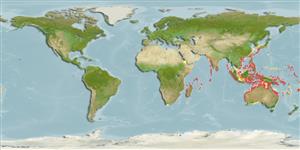Common names from other countries
Environment: milieu / climate zone / depth range / distribution range
Écologie
Récifal; profondeur 0 - 44 m (Ref. 81548). Tropical
Southeast Atlantic and Indo-West Pacific: South Africa to Australia and Japan.
Length at first maturity / Taille / Poids / Âge
Maturity: Lm ? range ? - ? cm
Maximum length of arms: 3.0 cm. Associated with coral communities. Dwells in a variety of substrates. Feeds on encrusting turf over hard substrates (Ref. 129602). Occurs in healthy shallow reef areas at depths of 1 to 25 m.
Life cycle and mating behavior
Maturité | Reproduction | Frai | Œufs | Fécondité | Larves
Members of the class Asteroidea exhibit both asexual (regeneration and clonal) and sexual (gonochoric) means of reproduction. Life cycle: Embryos hatch into planktonic larvae and later metamorphose into pentamorous juveniles which develop into young sea stars with stubby arms.
Schoppe, S. 2000. (Ref. 800)
Statut dans la liste rouge de l'IUCN (Ref. 130435)
statut CITES (Ref. 108899)
Not Evaluated
Not Evaluated
Menace pour l'homme
Harmless
Utilisations par l'homme
| FishSource |
Outils
Plus d'informations
Taille/Âge
Croissance
Longueur-poids
Longueur-longueur
Morphologie
Larves
Abondance
Sources Internet
Estimates based on models
Preferred temperature
(Ref.
115969): 24.4 - 29, mean 27.8 (based on 836 cells).
Catégorie de prix
Unknown.
